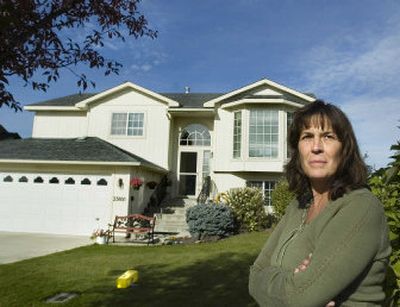Strict rules irk some at MeadowWood

It’s been described as a perfect community just waiting for its shade trees to grow.
But try as it does to be impeccable, Liberty Lake’s MeadowWood subdivision always has someone doing the neighborhood equivalent of walking around with his underwear outside his pants.
Someone’s front yard is in violation of the community’s mandatory tree quota. Someone’s motorcycle is parked in a driveway for God and everyone to see. Someone’s dog has soiled the neighborhood’s common area.
Such acts are forbidden in a community where the cheapest homes sell for $250,000 and not one, but three golf courses skirt the neighborhood.
Matters such as these are dealt with through enforcement of what the MeadowWood Homeowners Association manual calls “mutually beneficial restrictions,” aka 15 rules to live by – or else. “Mutually beneficial” because they keep property values as buoyant as cork in the Dead Sea, the rules don’t even allow homeowners to keep caged birds.
Peggy Armstrong got an “or else” notice last month after 10 years in the neighborhood. Seems her newspaper tube had caught the eye of a resident patrolling for infractions. At least that’s what she was told. Armstrong, who works for a wholesale pharmacy company, was at work, but her neighbor, Kate Hemenway, watched a woman in her late 40s drive up to Armstrong’s house and give it the once-over.
“I look outside, and I see this little Honda literally stopped in the middle of the street and this gal starts writing, writing … notes,” said Hemenway, who recognized the woman as a neighbor.
Within days, Armstrong was notified that her newspaper tube violated the neighborhood’s architectural rules. She was given a week to uproot the offending object, which her X-ray technician husband, Ken, threw on the front lawn after noticing nothing in the covenants preventing it from lying there.
Afterward, if Armstrong had committed similar violations, the fines would have escalated, starting at $100 and rising to $1,000 for the fourth violation.
The homeowners association has since backtracked due to a rules technicality, but its drive-by critiques have Armstrong taking her family photos down from the fireplace mantel and preparing to move. The people living around her literally are peeping through their curtains, eyeing not strangers, but neighbors.
“They’ll put a lien on your property,” Armstrong said. “Honestly, they will really do it.”
In less than a block, four homeowners in Armstrong’s neighborhood say they either have been spoken to or fear they’ll be spoken to for placing storage sheds in the wrong spot, leaving their garbage cans out too long or owning a satellite TV minidish. They blame the reports on malicious snooping.
“They’ll stop by and put a little door hanger on your door: ‘We have noticed that your x, y, z is in violation of so and so,’ ” said James Pappas, a MeadowWood neighbor.
A door hanger directs the residents to button it, stow it, move it or sell it with the real possibility of the neighborhood exercising its right to foreclose on a rule-breaker’s house should things go far enough.
Pappas sold his personal watercraft because storing them away from home was too much of a hassle and parking them in his driveway was taboo.
He has lived in the neighborhood nine years and says it didn’t used to be like this.
And it wasn’t.
MeadowWood used to be fairly lax with its rules, said Dennis Scott, president of the homeowners association.
The community of 970 homes had three homeowner committees, each representing about a third of the neighborhood. There was the Garden committee, the Greyhawk committee and so on.
The problem was the smaller committees struggled to get enough members together to make decisions.
So a bigger 12-member committee was formed in late 2004 to ride herd over all 970 homes.
It was gut-check time. More than $30,000 in outstanding homeowner dues were owed, the money used to pay for street lights and maintenance. The board leaned on neighbors to pony up.
It also got unpopularly aggressive about enforcing the rules.
After all, not everyone had signed the MeadowWood ownership contract without reading the rules; some actually had signed because of them.
“One of the first things we heard was: ‘How come the covenants aren’t being enforced?’ ” said Scott.
Scott also noted that the next thing the board heard was people calling it the “MeadowWood Gestapo.”
But not all of the board’s tactics were strong-arm.
There also were the board’s self-published, ever-cheerful news items.
“If you are thinking of painting lavender, lime green or orange, read this story for more info about (homeowners association)-approved paint colors.”
Or tips for keeping trees “happy” – alive and code-compliant.
Only two neighbors actually have been fined for code violations, Scott said.
And it takes two months of nonresponse before a homeowner is slapped with a $1,000 lien. Everybody else – the 20 or so people written up each month – comes into compliance quickly with the rules, almost as if they expected a knock on the door.